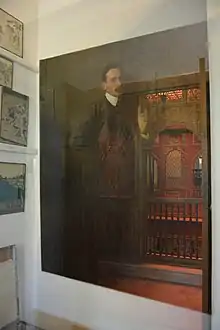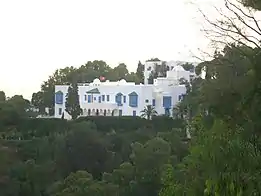

Baron Rodolphe d'Erlanger (b. Boulogne-Billancourt, France, June 7, 1872; d. Tunis, October 29, 1932) was a French painter and musicologist, specializing in North African and Arabic music.
Life and artistic career
Rodolphe François Baron d'Erlanger was the fourth son of German-French private banker Baron Frédéric Émile d'Erlanger and his American wife Marguerite Mathilde Slidell (1842–1927), daughter of businessman and politician John Slidell. His eldest brother Raphael Slidell d'Erlanger (1865–1897) was a zoologist and professor at Heidelberg. The second brother was Baron Emile Beaumont d'Erlanger (1866–1939) who took over the bank's management. His third brother Baron Frédéric Alfred d'Erlanger (1868–1943) also became a banker, but acquired acclaim as a composer as well. (See: Erlanger family tree).
Baron Rodolphe d'Erlanger studied in Paris and London. He was married to the Italian countess Maria Elisabetta Barbiellini-Amidei. Their only son, Leo Frédéric Alfred Baron d'Erlanger (1898–1978), eventually became the head of the family-owned bank which however he sold to Philip Hill Higginson Ltd. and its chairing partner Kenneth Keith, later Baron Keith of Castleacre, in 1958. The bank then became Philip Hill Higginson Erlanger Ltd., until a further fusion with M Samuel, then named Hill, Samuel & Co.
Contribution to the study of Arabic music and art
His palace at Sidi Bou Said, in northern Tunisia, which he named Ennejma Ezzahra (sometimes spelled Nejma Ezzohara), was built between 1909 and 1921.[1] The building is now a museum and houses the Centre des musiques arabes et méditerranéennes.
In the early 1930s and under the patronage of King Fuad I of Egypt, he was one of the persons who prepared the first Congress of Arabic Music, that took place in 1932 in Cairo. Although he was too ill to attend and died soon after, he sent an ensemble from Tunisia to perform at the Congress in Cairo.[2]
Apart from his collection of musical instruments, his studies on Arabic or North African music and sound recordings, he helped to revive the Tunisian musical genre known as ma'luf during the 1920s.[3] His lasting contribution to the ethnomusicology of Arabic music, however, was the six-volume "La musique arabe", published in Paris in French and Arabic from 1930 onwards, and re-edited in 2001 with the support of the Institut du Monde Arabe in Paris.[4]
References
- ↑ Cowell, Alan (1987-07-23). "In Tunisia, A Rare Visit To a Palace And Its Owner". The New York Times. ISSN 0362-4331. Retrieved 2019-01-05.
- ↑ Haclef, A. (1993). "Mohamed Ben Hassan et Mohamed Cherif. La Musique Classique Tunisienne Congres du Caire 1932 Malouf (Tunisie)". Bolingo. Retrieved 2019-01-05.
- ↑ "Le Baron Rudolf d'Erlanger (1872-1932), the Artist and the Savant « AMAR Foundation for Arab Music Archiving & Research". Retrieved 2020-08-21.
- ↑ Erlanger, Rodolphe (2001). La musique arabe (in French). Paris: Geuthner : Institut du Monde Arabe. ISBN 978-2-7053-3684-4. OCLC 65202100.